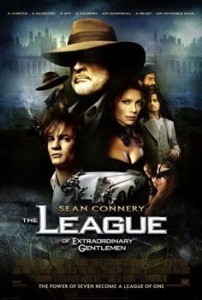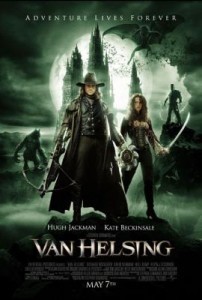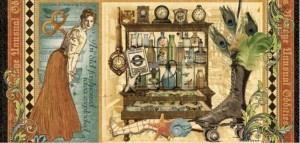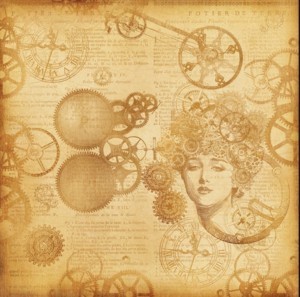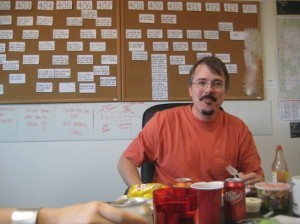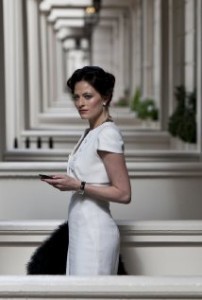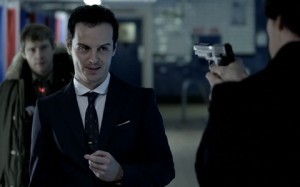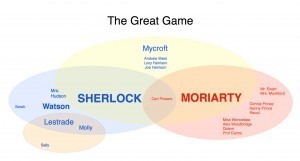Jennifer Crusie's Blog, page 280
January 17, 2014
Huh. The League of Extraordinary Gentlemen
Subtitle: Another 1890s movie watched for over-the-top period detail for research.
Okay, I know this one started life as a graphic novel, but I think adaptations should be judged as stories on their own, so I’m ignoring that. The one useful thing I got from the whole movie is the library set twenty-two minutes in, so I’m skipping over my writing notes and going to the story notes:
Richard Roxburgh is in everything.
Gorgeous submarine.
Why isn’t Mina in charge?
Too many principal characters.
Too much expository dialogue.
Very slow story.
Emotion: [I'm] mourning Venice, not people.
Too many characters attached to chaotic plot
Gray’s not very good at tying up loose ends, flashy escape not smart
Tom Sawyer hitting on Mina Harker: so wrong
STUPID plot
Recording as exposition fairy
Stuff with Hulk Hyde is great
Really beautiful production
Exposition killed this movie
Moriarty w/o Sherlock: combination [of characters] makes no sense
Why does Mina have an army of bats?
Maniacal laughter never works.
Mina vs. Gray: fun.
There were a couple of good movies buried in this mess.
Love the doppelgänger stuff.
Zombie Quatermain.
And now some more coherent thoughts:
I like the idea of the mix of fictional characters, a League of Supernatural Justice, but I don’t get Tom Sawyer in here. (I know, he wasn’t in the original, but we’re not talking about the original.) I think when you do ensemble pieces, the community you assemble has to make sense. The Avengers springs to mind, assembled by Nick Fury because of their personalities and talents. Or the Leverage group, deliberately chosen to do a high-tech heist. But this group is assembled by Moriarty so he can harvest their talents which is the dumbest idea any super-villain has ever come up with. “Let’s take my strongest enemies, bring them together, and then shoot at them so they fuse into a unit.” This must be the real Moriarty’s younger, dumber brother.
So you want Moriarty. Fine. Bring in Sherlock Holmes, that’s a no brainer. Keep vampire Mina although I still want to know why she gets an army of bats, and okay, if she has to have an army of bats, why don’t we ever see her with them? They’re really wonderful animals, little flying dachshunds that eat mosquitoes. Hers seem to have razor blades for wings, but that’s okay. I just think that’s a huge opportunity missed. Think of the promotional toys.
Where was I?
Right, you’ve got Sherlock instead of Quatermain (but you can keep Connery playing him) and Mina, and they seem like a natural, especially since we’re going for steampunk here. Then Captain Nemo absolutely fits although making the Nautilus look like part of the Carnival Cruise line kind of takes the steampunky tension off things; I kept looking for the open buffet and the girl in the sequined dress doing cover songs. The Invisible Man, Dorian Gray, Dr. Jekyll, all the right period, but it’s getting kinda crowded now. Then there’s Tom Sawyer who’s the wrong time period, the wrong country, and the wrong vibe. Whose idea was that, anyway? Also, I get that Moriarty wanted the people he wanted because he wanted to harvest their attributes, but there were much easier ways to do that, separately. How hard is it to get skin cells from the Invisible Man when he’s right there in your dining room, wearing a coat and mime make-up?
So if I were assembling a fin de siecle Avengers, I’d look at group dynamics. Sherlock Holmes for brains and masterminding things. Mina Harker for science and ripping people’s throat out, plus she has a bat army, always good. The Invisible Man for stealing things and spying. Captain Nemo for transportation and hand-to-hand combat with swords. I’ll even buy Hyde for muscle. What we’re missing, though, is the grifter/smooth talker, the Sophie, the Black Widow, the one that balances all the hand-to-hand stuff with mouth-to-mouth. It wasn’t Dorian Gray, he was just smarmy and annoying (really, Mina, what were you thinking?).
Which leads me to this conclusion: the thing that kneecaps these CGI-addicted movies isn’t just that they sacrifice character, doing exposition dumps to get past the hard work of actually showing character instead of just describing it, it’s that the characters they use are all the same incredibly powerful beings who solve everything with violence. In this movie, every major character gets his or her big battle at the end, but they’re all the same battle: as the Hulk would say, “SMASH.” Nobody wins by being clever, by outsmarting the other guy, by doing something unexpected. They’re all hammers, looking for nails.
Having said that, I did like the doppelgänger battles, especially Mina the Undead fighting Gray the Undead, but also Hyde vs Bad Super Hyde, and the Invisible Man vs Evil Invisible Man (that one less) and even Quatermain vs Moriarty, Mastermind vs Mastermind. The problem is, we know who’s going to win, the fun is in seeing how they win, and in the movie, they all win the same way: lots of bashing and good luck. If I have to watch five (?) final battles, I want five different final battles. Which, come to think of it, was probably why I enjoyed Mina vs. Gray so much, although I could have done without her look of horror as he died; what did she think was going to happen, a beautiful faint? The woman rips people’s throats out and then licks her lips, but a disintegrating corpse makes her eyes widen? Come on, Mina, this is the guy who betrayed you. If there was ever a time for maniacal laughter, it’s now.
So I think the key is, assemble a (small) group of people with interlocking skills (no great wealth or huge crews, bats excepted) and pit them against a mastermind that’s stronger and smarter than they are (no maniacal laughter or making your enemies into a team for no good reason or explaining your evil plan by monologuing in a filmstrip), and then showcase their characters by the variety in their conflict resolutions, not by having them explain themselves to each other and then solve everything by bashing something. Doppelgängers are good, and now that I’ve thought it through, I’m in favor of Mina’s cloud of bats, but no Tom Sawyer thrown in to get the teen girl vote. No huge factories with so many people running around in them you don’t know what the hell is going on. And no zombie Quatermain at the end. He fought the good fight, let him die.
Since somebody asked, tomorrow night I’m rewatching the Downey, Jr. Sherlock Holmes. I like that one, and I deserve a good one after this and Van Helsing. Then Adele Blanc Sec.
(I know Despicable Me 2 doesn’t fit. I watch it for the exhilaration.)

January 15, 2014
Fixing Van Helsing
(Not the character, Van Helsing, the hot mess movie Van Helsing from 2004.)
So I’m watching movies set in the 1890s this week, and tonight was Van Helsing. And here’s the thing: this could have been one of the great movies of all time with just a few admittedly major changes.
New Director: John Carpenter. Because the key to this movie is embracing the camp and the violence, and Carpenter has demonstrated that he has no fear when it comes to camp and violence.
Recast protagonist: Van Helsing: Kurt Russell. Because Russell can make the most ridiculous hero look good while delivering ridiculous hero dialogue like he was born ready. Also, he’d make that kiss work.
Recast love interest: Anna: Mary Louise Parker. Because Mary Louise Parker does the beauty with brains and edge bit, with all that anger and humor underneath. Also, she’d make that kiss work.
Recast antagonist: Dracula: James Spader. Because James Spader saves any film just by showing up. Also because no matter how bad the dialogue is, he can chill your bones just with his eyes. One problem: He’d never have gargoyles with Lindsay Lohan who’s my first pick for recasting the witches (all of them) so . . .
Recast the brides: Lindsay Lohan as all three Scarlet Johansson as all three Because miscellaneous women with big boobs don’t do it; cast all three with Lindsay Lohan Scarlet Johansson and let her chew the scenery with real menace, developing three different badass personalities.
Don’t mess with the stuff that works: keep David Wenham as Carl, Kevin J O’Connor as Igor, Schuler Hensley as the Monster, and Will Kemp as Velkan Valerious, the vacuous red shirt who was born to die.
Rationale: The thing about storytelling that’s this over-the-top is that you have to embrace it, not try to pretend it’s great drama. Case in point, that gag-inducing ending. There is nothing in this movie that says, “It’ll be okay because all the good people who die go to heaven except for Van Helsing, who should be dead after all of that except that we’re saving him for the sequel that is never going to happen.” The real problem is that this movie doesn’t say anything because it doesn’t know what the hell it is. If you’re going to do a character-driven drama, it has to be about character, not CGI. If you’re going to do an action-adventure, the girl doesn’t die in the end, and she especially doesn’t die at the end and then smile down at the hero from heaven while one silvery tear rolls down her dead cheek and he smiles ruefully back (“Sorry about that, honey”). You want to make Beaches, leave out the werewolves and the gargoyle babies. You want werewolves and gargoyle babies and big-boob-death flying at you, embrace the cheese with all your heart and soul.
And you know, the movie does whenever Carl is around. Carl is what this movie could have been. Okay, the humor is a little heavy-handed, but still, Carl rocks. And as much as I’m underwhelmed by the overuse of CGI here, there were parts that were amazing. Actually, all of the CGI was amazing, there was just too damn much of it and it was all THE BATTLE OF THE CENTURY, every battle indistinguishable from another except for the one that got Carl laid (“It’s all right, I’m a friar”). You want to BUILD, people. The CGI that stuck with me the most was the painting that moved and provided the clue. Cut about three of those battles and give me more subtlety like that, with Russell and Parker bantering as they fight flying Johansson and smiling Spader, throw in Carl and the Monster and Igor, and we’ve got ourselves a classic: Big Trouble in Little Transylvania. I would own three copies of that movie.
My notes: In two hours and twelve minutes, my notebook had four lines:
Absinthe
Secret society against supernatural evil
Carl: “I read.” Theoretical knowledge vs. practical knowledge
Masquerade ball
After that, it was all stuff on how I’d recast, and a note on how Carl was awesome at info dump.
Have you seen this movie? How would you fix it? Unless you liked it, in which case, uh, I’m sure you’re a really nice person who doesn’t judge.

Who Sunday on Wednesday: The Friends Credits
Found on io9 who got it from the Mary Sue, because I love this episode so much:

January 14, 2014
Ignore This Post
Yes, I know that’s catnip to you all, but I just need a place to put an image for an experiment. Then I’ll probably delete it. Or maybe not. Anyway, nothing to see here, move it along.

The Case for Paper
There are so many kinds of writing software out there now that there’s really no reason for office supplies any more. And yet I don’t know any writer who works solely on her computer. I have friends who actually write the first draft in longhand (that would be Gaffney, for one) which boggles my mind, but even for writers like me who’d never write a story if she didn’t have a keyboard, working with pen and paper at some point feels crucial. My personal crutch is quad paper, those quarter inch squares freeing me from linearity; no matter how much I think I’ve organized things, sooner or later I go looking for the grid to free things up. And then of course there’s the dry erase board and it’s lower tech cousin, the cork board and 3×5 card. Moving to New Jersey has meant that I’ve lost both, and I’m to the point now where I’m going to have to remodel the garage into a living space because it’s the only place with walls big enough to handle the cork and dry erase I need.
And it’s evidently not just novelists who feel this way. This excerpt from an interview with Breaking Bad‘s executive producer, Peter Gould, about the way things worked in the writers’ room is a great example of the way cork and 3×5 work:
There’s a great advantage to doing things by hand as opposed to electronically. I know not all show runners or all rooms run this way, but we’re all sitting there. Some of us are doodling or doing crafts, but the thing that we’re focused on is a corkboard which has three-by-five cards pinned to it. You can actually see pictures of this on the internet. There are a few that I think I’ve shared on my Twitter stream. It’s divided into acts, and these cards are somewhat laborious to write so there’s a certain commitment that you make as you put each final card up. It’s a pain in the ass to change them, and I think that one of the things you really look for is to talk about it as much as you possibly can, and then you commit. You say, “OK, this is what the scene is.”
If you look at the picture above and the others from the article by Dustin Rowles on Uproxx, you’ll see they’re not really describing scenes but beats, which is something I hadn’t thought of but that really makes sense. It’s much more freeing to think in key moments than in scenes because it doesn’t lock you down into a structure; you’ve just got character up there on those cards. If I had a cork board, I’d be doing that now. Damn it. Back to Home Depot and Staples.
I’m not sure why we’re drawn to the I-need-to-touch-paper part of writing. I think part of it is that story looks different every time you change its context; I do part of my rewriting on paper (the direct opposite of Gaffney) because the story on the screen is not the same story that comes out of my printer. The words are the same but they look different, it’s my story made fresh and I can see the flaws that I missed on the screen. Another part may be the need to make the story physical, to make the scene a card, to feel the relationships between the scenes flow from the pen into arrows on the quad paper, to see the shape of the characters’ names as you print them on the page, which, come to think of it, may be why Gaffney has to write first drafts in long hand. But there may be something there that’s just atavistic, that need to get your hands on the clay so you can feel what you’ve been dreaming become physical. Brain to computer still feels like dreaming. Words on paper feel like story.
Or at least they do to me. Is working on the computer enough for you (whatever it is you do) or do you, too, feel the need to touch words on paper in some way?

January 12, 2014
Next Sherlock Sunday: “A Scandal in Belgravia” by Steven Moffat
I get a little giddy when I talk about this episode. I’m a story wonk, so when I find a narrative this so-close-to-perfect-I’m-gonna-call-it-perfect, I tend to squee. The first time I saw this, I sat there at the end, knowing that last scene wouldn’t have happened, couldn’t logically have happened, and not caring because I was so damn glad it had happened. Then I hit play again and watched it all over again from the beginning. About a week later, I made Lani and Krissie watch it. When it was over, they just sat there, and I said, “Maybe I oversold this.” And then they both said, “Play it again.” It’s just that damn good. And one of the things that makes it so damn good is the brilliant use of metaphor and motif, so that’s what I’m going to talk about next Sunday.
One thing . . .
Amazon says the DVD for the first episode of season three isn’t going to be released until Feb. 11. If we can’t get it streaming online before then, I’m not going to be much help discussing them (no cable). I assumed if PBS was showing them on the 19th, Amazon, Netflix and the rest would stream shortly thereafter, but it’s looking like I’m wrong. If so, we’ll, uh, figure something out. Any ideas?

Sherlock Sunday 2: The Great Game by Mark Gatiss (Antagonists)
As great antagonists go, Moriarty is right up there with Nemesis, almost as much a legend as Sherlock Holmes. What’s really interesting about Gatiss’s interpretation of him is that he’s the perfect doppelgänger antagonist. That is, Moriarty is Sherlock Holmes’s double: both sociopaths, both pursuing superiority in the abstract, each confident that he’s the smartest guy in the room, disdainful of everyone else as inferior to him. Sherlock acknowledges the kinship when Lestrade asks him why the Moriarty is playing his games, and he says, “I can’t be the only person in London who gets bored.” Moriarty acknowledges it, too, when he says, “We were made for each other.” The first puzzle Moriarty gives Sherlock, the death of Carl Powers, Sherlock describes as his first effort at professional detection and it’s implied that it’s Moriarty’s first murder. Even their self-designations of “consulting detective” and “consulting criminal” are mirror images, so that when Sherlock describes Moriary with a gleam in his eye as “something new,” he’s paying his respects to the evildoer who finally deserves his talents. Moriarty is certifiable, and Sherlock is pretty close to that; he’d be locked up for observation if it weren’t for an understanding landlady who doesn’t call the cops when he shoots holes in her wall and an exasperated brother who pretty much runs Britain. Holmes and Moriarty really are the same person for most of this episode.
Of course the only thing about that dynamic that’s interesting is if one of the players changes. John’s exasperation with Sherlock’s lack of empathy for the hostages finally breaks through at the end when Sherlock, face to face with Moriarty for the first time, says, “People died,” and Moriarty screams, “That’s what people do!”, an echo of Sherlock’s earlier assertion that people are in danger of dying all the time and he can’t be bothered by that. But Moriarty has gone too far, killing people for sport as part of his game, a line Sherlock won’t cross, and that makes Moriarty not Sherlock’s twin but his foil, the comparison that refutes Sally’s assertion that Sherlock is a psychopath. Moriarty is a psychopath; Sherlock just needs empathy lessons. And he gets them at the end when he sees John wrapped in explosives. His emotions are triggered and he reacts with carefully controlled rage, not because Moriarty has out-smarted him but because he’s put John in mortal danger and Sherlock cares. Not only that, John demonstrates that he’s willing to die to save Sherlock, something that stuns Sherlock, blasts him out of his self-absorption into the real world. It’s an epiphany that only someone crazier than Sherlock could have brought about, in part because Sherlock can see himself in the monster that is Moriarty. At the end, facing both Watson and Moriarty, Sherlock has to do what Mycroft told John to do: Pick a side. And he picks humanity over intelligence, real life over the game. It’s the end of the first season character arc for Sherlock, but only the set-up for the huge arc he’s going to be subjected to in the first episode of season two, and it fulfills one of the objectives of a great conflict: an antagonist who, through the crucible of the conflict, reshapes the protagonist’s self-concept and makes him new. (And if you think Moriarty was good at that, wait’ll you get a load of Irene Adler.)
The brilliance of the dynamic of the doppleganger protagonist and antagonist are only marred by the incredibly stupid beginning and ending of this episode. I don’t know what the hell Sherlock was doing in Minsk–showing off?–and that cliffhanger ending is just annoying. The series is brilliant, as viewers we’d definitely come back the following season, so leaving Moriarty and Sherlock staring each other down after Sherlock’s had his epiphany is just dumb, especially since it’s resolved in the next episode by Moriarty changing his mind. Because he’s, you know, crazy. But he’s not, you know, stupid, so why the whole circus act? That’s why the Argh cut of this episode lops off Minsk and the point at the end where Moriarty comes back in. Really, it’s better that way.
So what did you think?
Edited to add: We’re doing character mapping in McDaniel this week, so I mapped this episode since a few of the students are playing along here (click to enlarge):

January 11, 2014
Cherry Saturday: Jan. 11, 2014
January is Hot Tea Month, National Oatmeal Month, and National Soup Month. Eat warm, people.

January 8, 2014
Apologies
To those of you caught in moderation, I apologize. WordPress changed the dashboard and I can’t see the people in moderation now without clicking a link, which I just clinked and was appalled to find eight of you in there, some for three days. Really sorry about that.

I Heart WeatherSpark
Accuweather has always been my go-to weather site. I know some people swear by The Weather Channel, but those people are just odd. They keep calling this snow and cold situation Hercules even though nobody names snowstorms. Why? Because storms with names get more hits, and if they’re the only site calling it Hercules . . . Plus have you seen some of the links on that site? Do not get me started. Where was I? Oh, right, Accuweather has always been my go-to place for forecasts. But since I’ve been coping with the cold in a house with no furnace, I’ve gotten obsessive about checking EVERYWHERE: Accuweather, Wunderground, even The Weather Channel . . . and then I found WeatherSpark and stopped dating around. From now on, it’s me and WeatherSpark 4Ever.
WeatherSpark gives you the whole deal in one graph. No clicking through links, you just slide the chart back and forth to see where you’re going and where you’ve been. It’s simple and elegant and beautiful and I love it and you should all go check out WeatherSpark if you’re obsessing about how the weather is going to possibly make your life hell in the days to come.
And then just for a little weather zen, go look at the Wind Map again. It’s the visual equivalent of yoga music.
WeatherSpark and the Wind Map. That’s all the meteorology you really need.


